Text
just a reminder to COMPLETELY boycott Eurovision this year; Azerbaijan and Israel, despite committing genocide, are STILL allowed to compete & have NOT been banned. by refusing to ban both countries, Eurovision is profiting off of the genocide of Palestinians and Armenians.
do not listen to the artists. do not pirate or stream the artists' music, and this applies to ALL the artists who are competing and performing this year. do not listen to the songs on ANY platform, do not give them ANY attention.
write to your broadcasters and tell them you REFUSE to watch the channels until they recognise the Armenian and Palestinian genocides & that you find it disgusting how they are allowing Eurovision despite Azerbaijan and Israel's entries.
do NOT give eurovision OR the competing artists ANYTHING but silence.
boycott ALL of eurovision.
20K notes
·
View notes
Text
A lot of younger people have no idea what aging actually looks and feels like, and the reasons behind it. That ignorance is so dangerous. If you don’t want to “be old,” you aren’t talking about a number of years. I have patients in their late 80s who could still handily beat me in a race—one couple still runs marathons together, in their late 80s—and I lost someone who was in her early 60s to COPD last year. What you want is not youth, it is health.
If you want to still be able to enjoy doing things in your 60s and 70s and 80s and even 90s, what you want to do, right now, is quit smoking, get some activity on a regular basis (a couple of walks a week is WAY better for you than nothing; increasing from 1 hour a day of cardio to 1.5 will buy you very little), and eat some plants. That’s it. No magic to it. No secret weird tricks. Don’t poison yourself, move around so your body doesn’t forget how, and eat plants.
If you have trouble moving around now because of mobility limitations, bad news: you still need to move around, not because it’s immoral not to, but because that’s still the best advice we have. I highly recommend looking up the Sit and Be Fit series; it is freely available and has exercises that can be done in a chair, which are suitable for people with limited mobility or poor balance. POTS sufferers, I’m looking at you.
If you have trouble eating plants because of dietary issues (they cause gas, etc.) or just because they’re bitter (super taster with texture issues here!), bad news. You still want to find a way to get some plants into your body on a regular basis. I know. It sucks. The only way I can do it is restaurants—they can make salads taste like food. I can also tolerate some bagged salads. On bad weeks, the OCD with contamination focus gets so bad I just can’t. However, canned beans always seem “safe,” and they taste a bit like candy, so they’re a good fallback.
If you smoke and you have tried quitting a million times and you’re just not ready to, bad news. You still need to quit. Your body needs you to try and keep trying. Your brain needs it, too. Damaging small blood vessels racks up cumulative damage over time that your body can start trying to reverse as soon as you quit. I know it’s insanely, absurdly addictive. You still need to.
You cannot rules lawyer your way past your body’s basic needs. It needs food, sleep, activity, and the absence of poison. Those are both small things and big asks. You cannot sustain a routine based on punishment, so don’t punish your body. Find ways to include these things that are enjoyable and rewarding instead. Experiment. There is no reason not to experiment—you don’t have to know instantly what’s going to work for you and what won’t, you just need to be willing to try things and make changes when things aren’t working for you.
You will still age. Your body will stop making collagen and elastin. Tissues you can see and tissues you can’t see will both sag. Cushioning tissues under your skin will get thinner. You’ll bruise more easily. Skin will tear more easily. Accumulated sun damage will start to show more and more. Joints will begin to show arthritis. Tendons and ligaments will get weaker and get injured more easily, as will muscles. Bones will lose mass and get easier to break. You’ll get tired more easily.
But you know what makes the difference between being dead, or as good as, in your 60s vs your 90s? Activity, plants, and quitting smoking. And don’t do meth. Saw a 58-year-old guy this week who is going to have a heart attack if he doesn’t quit whatever stimulant he’s on. I pretended to believe it was just the cigarettes, and maybe it is, but meth and cocaine will kill you quicker. Stop poisoning yourself.
Baby steps; take it one step at a time; you don’t need to have everything figured out right now. But you do need to be working on figuring things out.
3K notes
·
View notes
Text

So I got this tag on my answer to an ask about when it became acceptable for western women to wear pants, and you know it's all I need to go on a tangent.
I think the short answer here would be men have worn skirts as long as people have worn anything, so pretty long tbh. But since I am incapable of answering anything shortly, I think we can re-frame this question:
When did skirts stop being socially acceptable for men?
So let's start with acknowledging that tunics, togas, kirtles and such men wore through history were, in fact, skirts. I think there's often a tendency to think of these as very different garments from those that women wore, but really they are not. Most of the time they were literally referred to with the same name. (I will do a very broad and simplified overview of men's clothing from ancient times to Early Middle Ages so we can get to the point which is Late Middle Ages.)
Ancient Greek men and women both wore chitons. Even it's length wasn't determined by gender, but by occupation. Athletes, soldiers and slaves wore knee-length chitons for easier movement. Roman men and women wore very similar garment, tunics. Especially in earlier ancient Rome long sleeves were associated with women, but later became more popular and unconventional for men too. Length though was still dependent on occupation and class, not gender. Toga was sure men's clothing, but worn over tunic. It was wrapped around the waist, like a dress would, and then hung over shoulder. Romans did wear leggings when they needed to. For example for leg protection when hunting as in this mosaic from 4th century. They would have been mostly used by men since men would be doing the kinds of activities that would require them. But that does not lessen the dressyness of the tunics worn here. If a woman today wears leggings under her skirt, the skirt doesn't suddenly become not a skirt.
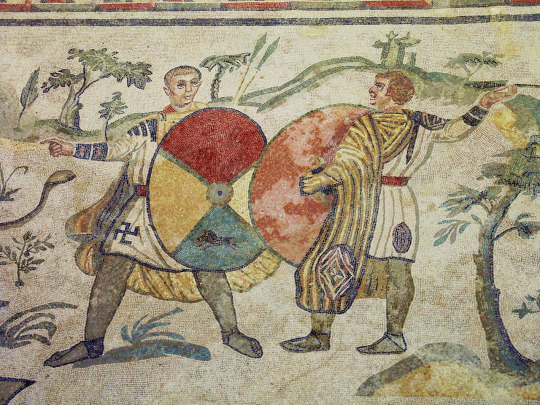
All over Europe thorough the early Middle Ages, the clothes were very similar in their basic shape and construction as in Rome and Greece. In Central and Northern Europe though people would wear pants under shorter tunics. There were exceptions to the everyone wearing a tunic trend. Celtic men wore braccae, which were pants, and short tunics and literally just shirts. Celts are the rare case, where I think we can say that men didn't wear dresses. Most other peoples in these colder areas wore at least knee-length tunics. Shorter tunics and trousers were worn again mostly by soldiers and slaves, so rarely any other woman than slave women. The trousers were though definitely trousers in Early Middle Ages. They were usually loose for easier construction and therefore not that similar to Roman leggings. However leggings style fitted pants were still used, especially by nobility. I'd say the loose trousers are a gray area. They wore both dresses and pants, but still definitely dresses. I'd say this style was very comparable to the 2000s miniskirts over jeans style. First one below is a reconstruction of Old Norse clothing by Danish history museum. The second is some celebrity from 2005. I see no difference.
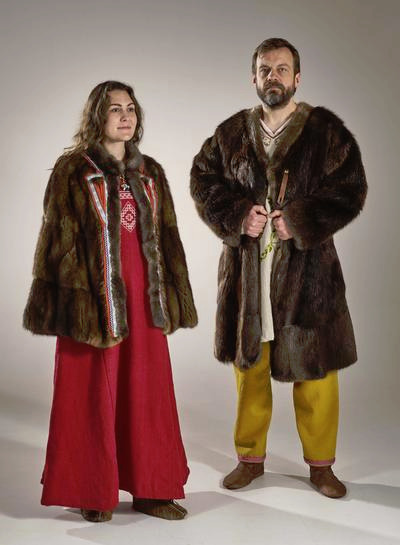
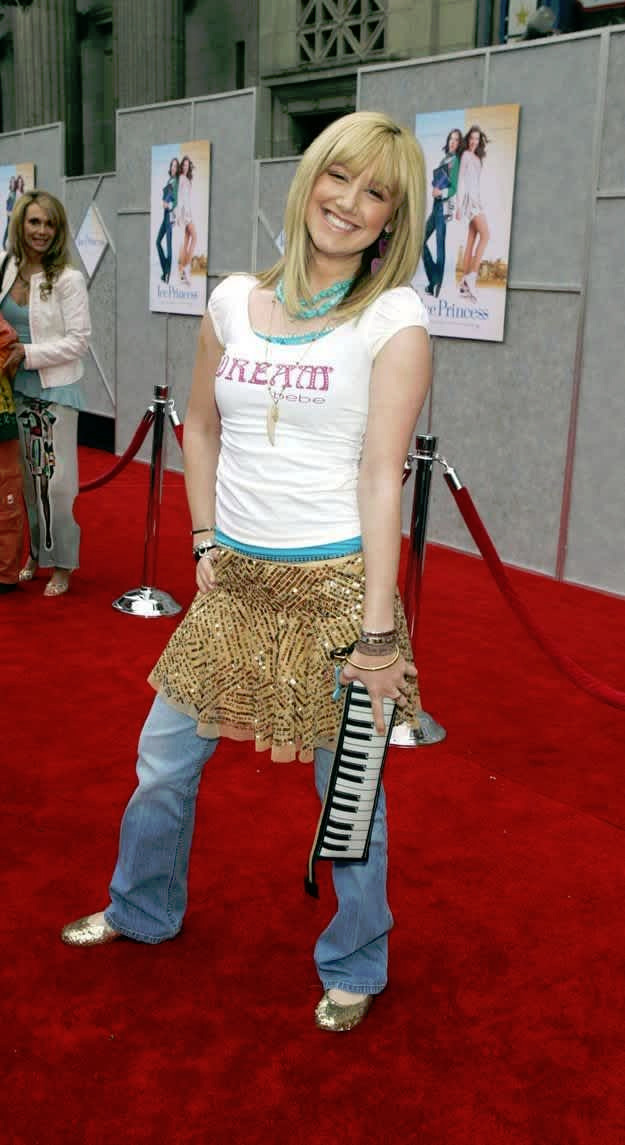
When we get to the high Middle Ages tunics are still used by both men and women, and still it's length is dependent on class and activity more than gender, but there's some new developments too. Pants and skirt combo is fully out and leggings' are back in in form of hose. Hose were not in fact pants and calling them leggings is also misleading. Really they are socks. Or at least that's how they started. As it has become a trend here they were used by everyone, not just men. During early Middle Ages they were worn often with the trousers, sometimes the trousers tucked inside them making them baggy. In high Middle Ages they became very long when used with shorter tunics, fully displacing the need for trousers. They would be tied to the waist to keep them up, as they were not knitted (knitting was being invented in Egypt around this time, and some knitting was introduced to Europe during middle Ages, but it really only took off much later during Renaissance Era) and therefore not stretchy. First picture is an example of that from 1440s. Another exciting development in the High Medieval era was bliaut in France and it's sphere of influence. Bliaut was an early attempt in Europe of a fitted dress. And again used by both men and women. The second illustration below from mid 12th century shows a noble man wearing a bliaut and nicely showing off his leg covered in fitted hose. Bliaut was usually likely fitted with lacing on the sides, but it wasn't tailored (tailoring wasn't really a thing just yet) and so created a wrinkled effect around the torso.
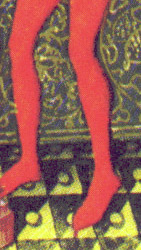

In the 14th century things really picked up in European fashion. European kingdoms finally started to become richer and the rich started to have some extra money to put into clothing, so new trends started to pop up rapidly. Tailoring became a thing and clothes could be now cut to be very fitted, which gave birth to fitted kirtle. At the same time having extra money meant being able to spend extra money on more fabric and to create very voluminous clothing, which gave birth to the houppelande.
Kirtle was once again worn by everyone. It wasn't an undergarment, for women that would be shift and men shirt and breeches, but it was an underlayer. It could be worn in public but often had at least another layer on top of it. The bodice part, including sleeves were very fitted with lacing or buttons (though there were over-layer kirtles that had different sleeves that changed with fashions and would be usually worn over a fitted kirtle). Men's kirtles were short, earlier in 14th century knee-length but towards the end of the century even shorter styles became fashionable in some areas. First picture below shows a man with knee-length kirtle from 1450s Italy.
Houppelande was also unisex. It was a loose full-length overgown with a lot of fabric that was gathered on the neckline and could be worn belted or unbelted. The sleeves were also wide and became increasingly wider (for men and women) later in the century and into the next century. Shorter gowns similar in style and construction to the houppelande were also fashionable for men. Both of these styles are seen in the second picture below from late 14th century.
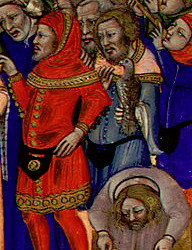

In the very end of 14th century, first signs of pantification of men can be seen. In France and it's sphere of influence the skirt part of the kirtle became so short it barely covered the breeches as seen below on these fashionable musicians from 1395-1400 France. Long houppelandes, length ranging from floor to calf, were still used by men though (the second picture, 1414 France), as were knee and thigh length gowns of similar loose style.

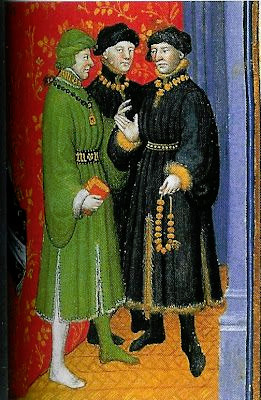
The hems continued to be short through the 15th century in France, but in other places like Italy and German sphere of influence, they were still fairly long, at least to mid thigh, through the first half of the century. In France at some point in late 13th century the very short under-kirtle started to be called doublet and they are just getting shorter in 1400s. The showing underwear problem was fixed by joined hose and the codpiece, signaling the entrance of The Sluttiest Era of men's fashion. Below is an example from 1450s Belgium of doublet and early codpiece in display. As you can see from the other figures, the overgowns of the previous century were also getting very, very short. In the next French example below from 1470s we can see the skirt shrink out of existence right before our eyes.
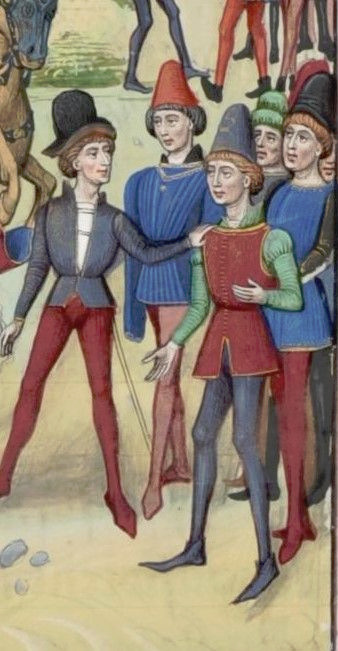

The very skimpy doublet and it's accompanying codpiece spread to the rest of the Europe in the second half of 15th century and it would only get sluttier from there. The Italians were just showing their full ass (example from 1490s). The dress was not gone yet though. The doublet and codpiece continued to be fashionable, but the overdress got longer again in the French area too. For example in the second example there's Italian soldiers in a knee length dresses from 1513.
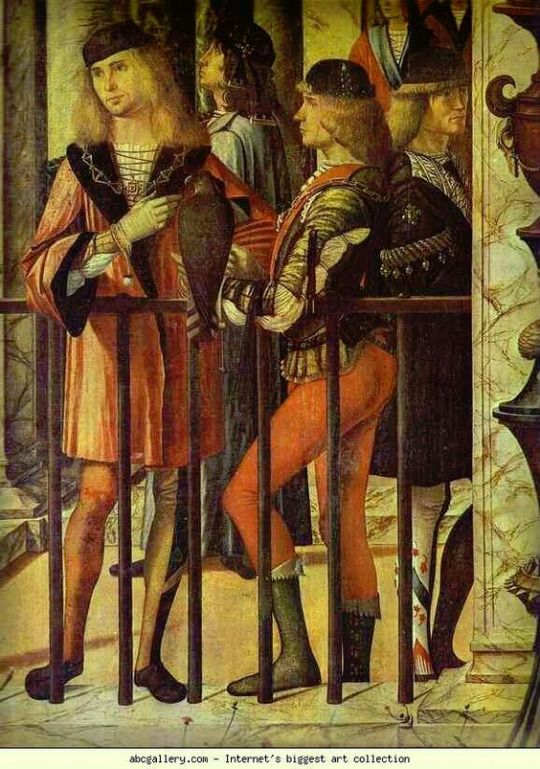
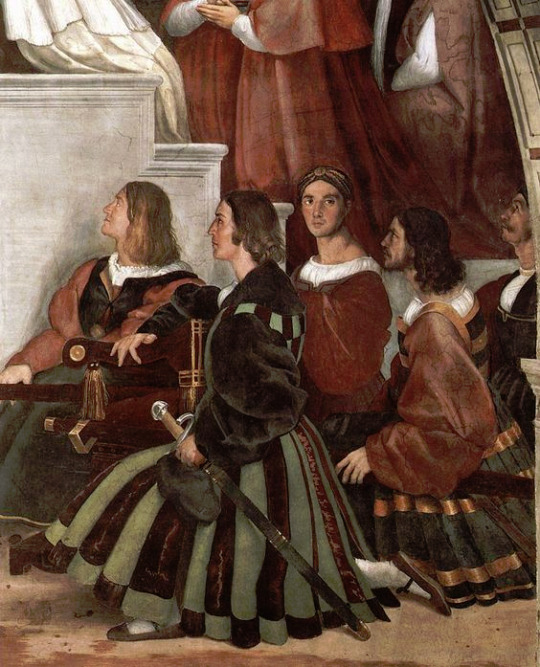
But we have to talk about the Germans. They went absolutely mad with the whole doublet and codpiece. Just look at this 1513 painting below (first one). But they did not only do it sluttier than everyone else, they also changed the course of men's fashion.
Let's take a detour talking about the Landsknecht, the mercenary pikeman army of the Holy Roman Empire. (I'm not that knowledgeable in war history so take my war history explanation with a grain of salt.) Pikemen had recently become a formidable counter-unit against cavalry, which earlier in the Medieval Era had been the most important units. Knights were the professional highly trained cavalry, which the whole feudal system leaned against. On the other hand land units were usually not made of professional soldiers. Landsknecht were formed in late 15th century as a professional army of pikemen. They were skilled and highly organized, and quickly became a decisive force in European wars. Their military significance gave them a lot of power in the Holy Roman Empire, some were even given knighthood, which previously wasn't possible for land units, and interestingly for us they were exempt from sumptuary laws. Sumptuary laws controlled who could wear what. As the bourgeois became richer in Europe in late Middle Ages and Renaissance Era, laws were enacted to limit certain fabrics, colors and styles from those outside nobility, to uphold the hierarchy between rich bourgeois and the nobles. The Landsknecht, who were well payed mercenaries (they would mutiny, if they didn't get payed enough), went immediately absolute mad with the power to bypass sumptuary laws. Crimes against fashion (affectionate) were committed. What do you do, when you have extra money and one of your privileges is to wear every color and fabric? You wear every color and fabric. At the same time. You wear them on top of each other and so they can be seen at the same time, you slash the outer layer. In the second image you can feast your eyes on the Landsknecht.


Just to give you a little more of that good stuff, here's a selection of some of my favorite Landsknecht illustrations. This is the peak male performance. Look at those codpieces. Look at those bare legs. The tiny shorts. And savor them.
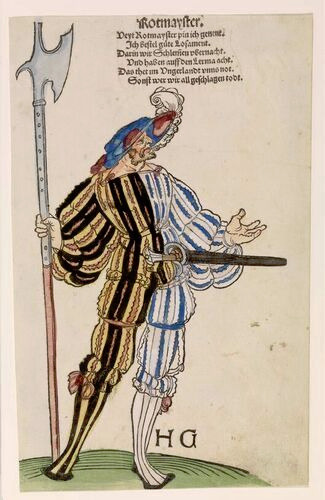
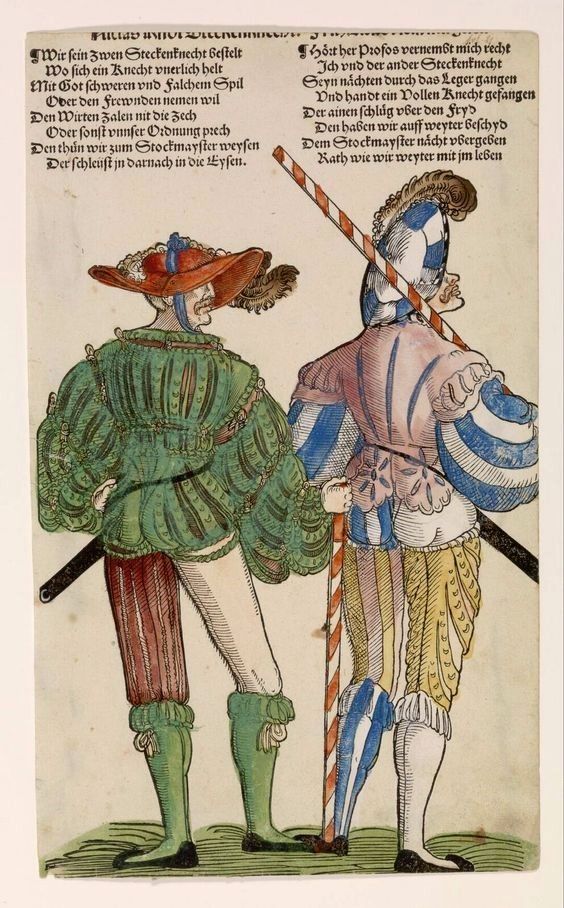
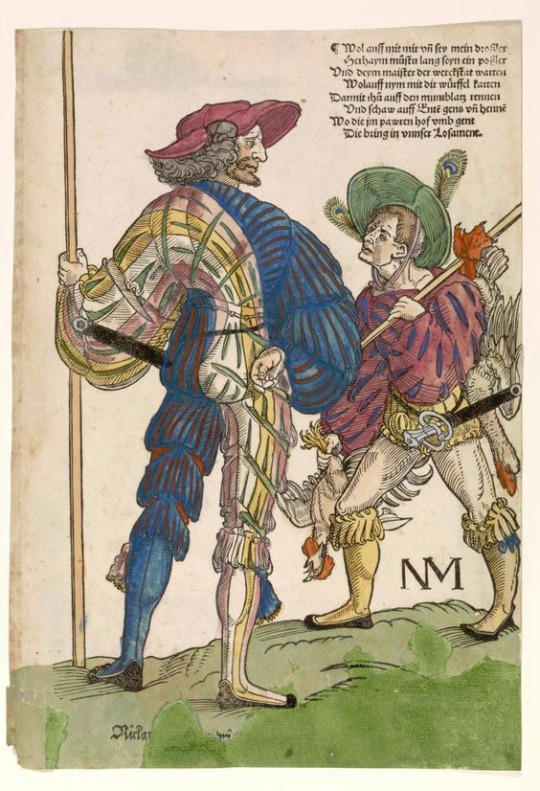
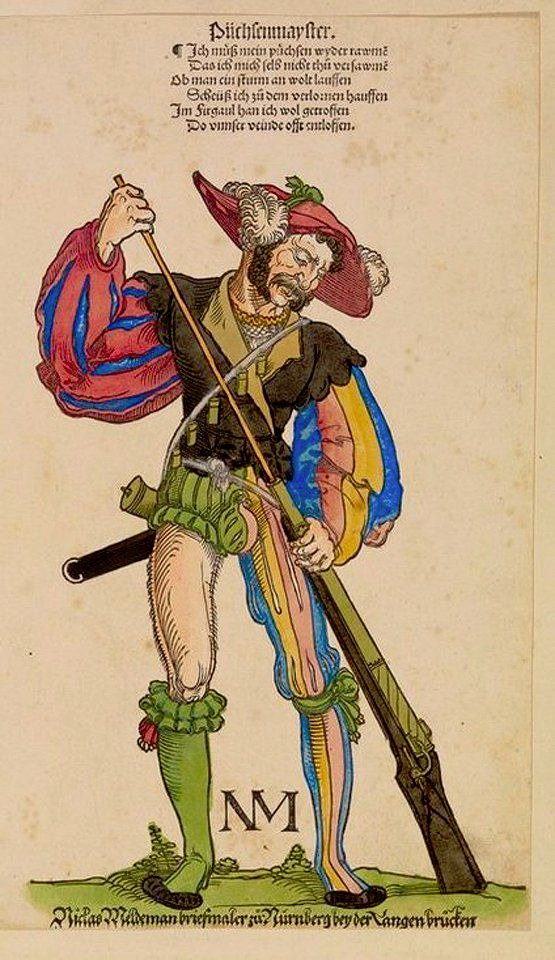
The Landsknecht were the hot shit. Their lavish and over the top influence quickly took over men's fashion in Germany in early 1500s. Slashing, the technique possibly started by them, but at least popularized by them, instantly spread all over Europe. That's how you get the typical Renaissance poof sleeves. They at first slashed the thighs of their hose, but it seems like to fit more of everything into their outfits, they started wearing the hose in two parts, upper hose and nether hose, which was a sort of return to the early Medieval trousers and knee-high hose style. The two part hose was adopted by the wider German men's fashion early in the century, but already in 1520s had spread to rest of Europe. It was first combined with the knee-length overdress that had made it's comeback in the turn of the century, like in this Italian painting from 1526 (first image). At this point knitting had become established and wide-spread craft in Europe and the stockings were born, replacing nether hose. They were basically nether hose, but from knitted fabric. The gown shortened again and turned into more of a jacket as the trunk hose became increasingly the centerpiece of the outfit, until in 1560s doublet - trunk hose combination emerged as the standard outerwear (as seen in the second example, 1569 Netherlands) putting the last nail on the coffin of the men's dress as well as the Sluttiest Era. The hose and doublet became profoundly un-slutty and un-horny, especially when the solemn Spanish influence spread all over with it's dark and muted colors.


Especially in Middle Ages, but thorough European history, trousers have been associated with soldiers. The largely accepted theory is that trousers were invented for horse riding, but in climates with cold winters, where short skirts are too cold, and long skirts are still a hazard when moving around, trousers (with or without a short skirt) are convenient for all kinds of other movement requiring activities like war. So by adopting hose as general men's clothing, men in 1500s associated masculinity with militarism. It was not a coincidence that the style came from Landsknecht. I may have been joking about them being "peak male performance", but really they were the new masculine ideals for the new age. At the time capitalism was taking form and European great powers had begun the process of violently conquering the world for money, so it's not surprising that the men, who fought for money and became rich and powerful doing so, were idealised.
Because of capitalism and increasingly centralized power, the feudal system was crumbling and with it the feudal social hierarchy. Capitalism shifted the wealth from land ownership (which feudal nobility was built upon) to capital and trade, deteriorating the hierarchy based on land. At the same time Reformation and centralized secular powers were weakening the power of the Church, wavering also the hierarchy justified by godly ordain. The ruling class was not about to give up their power, so a new social hierarchy needed to form. Through colonialism the concept of race was created and the new hierarchy was drawn from racial, gender and wealth lines. It was a long process, but it started in 1500s, and the increasing distinction between men's and women's fashions was part of drawing those lines. At the same time distinctions between white men and racialized men, as well as white women and racialized women were drawn. As in Europe up until this point, all over the world (with some exceptions) skirts were used by everyone. So when European men fully adopted the trousers, and trousers, as well as their association to military, were equated with masculinity, part of it was to emasculate racialized men, to draw distinctions.
Surprise, it was colonialism all along! Honestly if there's a societal or cultural change after Middle Ages, a good guess for the reason behind it is always colonialism. It won't be right every time, but quite a lot of times. Trousers as a concept is of course not related to colonialism, but the idea that trousers equal masculinity and especially the idea that skirts equal femininity are. So I guess decolonize masculinity by wearing skirts?
3K notes
·
View notes
Text
"I want a Persephone story that focuses on Persephone's agency as a young woman" you want Psyche
"I want a Persephone story about a bad/abusive mom and toxic mother/child relationship" you want Psyche
"I want a Persephone that saves herself" you want Psyche
"I want a Persephone story where she falls in love with the monster" you want Psyche
"I want a Persephone story where she rescues her lover" you want Psyche
"I want a Persephone story where the monster/villain falls in love with her" you want Psyche
"I want a Persephone story where she's a strong, independent heroine" you want Psyche
"I want a Persephone story where she isn't kidnapped and held against her will but instead goes and sacrifices herself willingly/chooses to stay with her lover" YOU WANT PSYCHE
5K notes
·
View notes
Photo

illustration of atalanta and the calydonian boar i did for the dames anthology
7K notes
·
View notes
Text

So I got this tag on my answer to an ask about when it became acceptable for western women to wear pants, and you know it's all I need to go on a tangent.
I think the short answer here would be men have worn skirts as long as people have worn anything, so pretty long tbh. But since I am incapable of answering anything shortly, I think we can re-frame this question:
When did skirts stop being socially acceptable for men?
So let's start with acknowledging that tunics, togas, kirtles and such men wore through history were, in fact, skirts. I think there's often a tendency to think of these as very different garments from those that women wore, but really they are not. Most of the time they were literally referred to with the same name. (I will do a very broad and simplified overview of men's clothing from ancient times to Early Middle Ages so we can get to the point which is Late Middle Ages.)
Ancient Greek men and women both wore chitons. Even it's length wasn't determined by gender, but by occupation. Athletes, soldiers and slaves wore knee-length chitons for easier movement. Roman men and women wore very similar garment, tunics. Especially in earlier ancient Rome long sleeves were associated with women, but later became more popular and unconventional for men too. Length though was still dependent on occupation and class, not gender. Toga was sure men's clothing, but worn over tunic. It was wrapped around the waist, like a dress would, and then hung over shoulder. Romans did wear leggings when they needed to. For example for leg protection when hunting as in this mosaic from 4th century. They would have been mostly used by men since men would be doing the kinds of activities that would require them. But that does not lessen the dressyness of the tunics worn here. If a woman today wears leggings under her skirt, the skirt doesn't suddenly become not a skirt.

All over Europe thorough the early Middle Ages, the clothes were very similar in their basic shape and construction as in Rome and Greece. In Central and Northern Europe though people would wear pants under shorter tunics. There were exceptions to the everyone wearing a tunic trend. Celtic men wore braccae, which were pants, and short tunics and literally just shirts. Celts are the rare case, where I think we can say that men didn't wear dresses. Most other peoples in these colder areas wore at least knee-length tunics. Shorter tunics and trousers were worn again mostly by soldiers and slaves, so rarely any other woman than slave women. The trousers were though definitely trousers in Early Middle Ages. They were usually loose for easier construction and therefore not that similar to Roman leggings. However leggings style fitted pants were still used, especially by nobility. I'd say the loose trousers are a gray area. They wore both dresses and pants, but still definitely dresses. I'd say this style was very comparable to the 2000s miniskirts over jeans style. First one below is a reconstruction of Old Norse clothing by Danish history museum. The second is some celebrity from 2005. I see no difference.


When we get to the high Middle Ages tunics are still used by both men and women, and still it's length is dependent on class and activity more than gender, but there's some new developments too. Pants and skirt combo is fully out and leggings' are back in in form of hose. Hose were not in fact pants and calling them leggings is also misleading. Really they are socks. Or at least that's how they started. As it has become a trend here they were used by everyone, not just men. During early Middle Ages they were worn often with the trousers, sometimes the trousers tucked inside them making them baggy. In high Middle Ages they became very long when used with shorter tunics, fully displacing the need for trousers. They would be tied to the waist to keep them up, as they were not knitted (knitting was being invented in Egypt around this time, and some knitting was introduced to Europe during middle Ages, but it really only took off much later during Renaissance Era) and therefore not stretchy. First picture is an example of that from 1440s. Another exciting development in the High Medieval era was bliaut in France and it's sphere of influence. Bliaut was an early attempt in Europe of a fitted dress. And again used by both men and women. The second illustration below from mid 12th century shows a noble man wearing a bliaut and nicely showing off his leg covered in fitted hose. Bliaut was usually likely fitted with lacing on the sides, but it wasn't tailored (tailoring wasn't really a thing just yet) and so created a wrinkled effect around the torso.


In the 14th century things really picked up in European fashion. European kingdoms finally started to become richer and the rich started to have some extra money to put into clothing, so new trends started to pop up rapidly. Tailoring became a thing and clothes could be now cut to be very fitted, which gave birth to fitted kirtle. At the same time having extra money meant being able to spend extra money on more fabric and to create very voluminous clothing, which gave birth to the houppelande.
Kirtle was once again worn by everyone. It wasn't an undergarment, for women that would be shift and men shirt and breeches, but it was an underlayer. It could be worn in public but often had at least another layer on top of it. The bodice part, including sleeves were very fitted with lacing or buttons (though there were over-layer kirtles that had different sleeves that changed with fashions and would be usually worn over a fitted kirtle). Men's kirtles were short, earlier in 14th century knee-length but towards the end of the century even shorter styles became fashionable in some areas. First picture below shows a man with knee-length kirtle from 1450s Italy.
Houppelande was also unisex. It was a loose full-length overgown with a lot of fabric that was gathered on the neckline and could be worn belted or unbelted. The sleeves were also wide and became increasingly wider (for men and women) later in the century and into the next century. Shorter gowns similar in style and construction to the houppelande were also fashionable for men. Both of these styles are seen in the second picture below from late 14th century.


In the very end of 14th century, first signs of pantification of men can be seen. In France and it's sphere of influence the skirt part of the kirtle became so short it barely covered the breeches as seen below on these fashionable musicians from 1395-1400 France. Long houppelandes, length ranging from floor to calf, were still used by men though (the second picture, 1414 France), as were knee and thigh length gowns of similar loose style.


The hems continued to be short through the 15th century in France, but in other places like Italy and German sphere of influence, they were still fairly long, at least to mid thigh, through the first half of the century. In France at some point in late 13th century the very short under-kirtle started to be called doublet and they are just getting shorter in 1400s. The showing underwear problem was fixed by joined hose and the codpiece, signaling the entrance of The Sluttiest Era of men's fashion. Below is an example from 1450s Belgium of doublet and early codpiece in display. As you can see from the other figures, the overgowns of the previous century were also getting very, very short. In the next French example below from 1470s we can see the skirt shrink out of existence right before our eyes.


The very skimpy doublet and it's accompanying codpiece spread to the rest of the Europe in the second half of 15th century and it would only get sluttier from there. The Italians were just showing their full ass (example from 1490s). The dress was not gone yet though. The doublet and codpiece continued to be fashionable, but the overdress got longer again in the French area too. For example in the second example there's Italian soldiers in a knee length dresses from 1513.


But we have to talk about the Germans. They went absolutely mad with the whole doublet and codpiece. Just look at this 1513 painting below (first one). But they did not only do it sluttier than everyone else, they also changed the course of men's fashion.
Let's take a detour talking about the Landsknecht, the mercenary pikeman army of the Holy Roman Empire. (I'm not that knowledgeable in war history so take my war history explanation with a grain of salt.) Pikemen had recently become a formidable counter-unit against cavalry, which earlier in the Medieval Era had been the most important units. Knights were the professional highly trained cavalry, which the whole feudal system leaned against. On the other hand land units were usually not made of professional soldiers. Landsknecht were formed in late 15th century as a professional army of pikemen. They were skilled and highly organized, and quickly became a decisive force in European wars. Their military significance gave them a lot of power in the Holy Roman Empire, some were even given knighthood, which previously wasn't possible for land units, and interestingly for us they were exempt from sumptuary laws. Sumptuary laws controlled who could wear what. As the bourgeois became richer in Europe in late Middle Ages and Renaissance Era, laws were enacted to limit certain fabrics, colors and styles from those outside nobility, to uphold the hierarchy between rich bourgeois and the nobles. The Landsknecht, who were well payed mercenaries (they would mutiny, if they didn't get payed enough), went immediately absolute mad with the power to bypass sumptuary laws. Crimes against fashion (affectionate) were committed. What do you do, when you have extra money and one of your privileges is to wear every color and fabric? You wear every color and fabric. At the same time. You wear them on top of each other and so they can be seen at the same time, you slash the outer layer. In the second image you can feast your eyes on the Landsknecht.


Just to give you a little more of that good stuff, here's a selection of some of my favorite Landsknecht illustrations. This is the peak male performance. Look at those codpieces. Look at those bare legs. The tiny shorts. And savor them.




The Landsknecht were the hot shit. Their lavish and over the top influence quickly took over men's fashion in Germany in early 1500s. Slashing, the technique possibly started by them, but at least popularized by them, instantly spread all over Europe. That's how you get the typical Renaissance poof sleeves. They at first slashed the thighs of their hose, but it seems like to fit more of everything into their outfits, they started wearing the hose in two parts, upper hose and nether hose, which was a sort of return to the early Medieval trousers and knee-high hose style. The two part hose was adopted by the wider German men's fashion early in the century, but already in 1520s had spread to rest of Europe. It was first combined with the knee-length overdress that had made it's comeback in the turn of the century, like in this Italian painting from 1526 (first image). At this point knitting had become established and wide-spread craft in Europe and the stockings were born, replacing nether hose. They were basically nether hose, but from knitted fabric. The gown shortened again and turned into more of a jacket as the trunk hose became increasingly the centerpiece of the outfit, until in 1560s doublet - trunk hose combination emerged as the standard outerwear (as seen in the second example, 1569 Netherlands) putting the last nail on the coffin of the men's dress as well as the Sluttiest Era. The hose and doublet became profoundly un-slutty and un-horny, especially when the solemn Spanish influence spread all over with it's dark and muted colors.


Especially in Middle Ages, but thorough European history, trousers have been associated with soldiers. The largely accepted theory is that trousers were invented for horse riding, but in climates with cold winters, where short skirts are too cold, and long skirts are still a hazard when moving around, trousers (with or without a short skirt) are convenient for all kinds of other movement requiring activities like war. So by adopting hose as general men's clothing, men in 1500s associated masculinity with militarism. It was not a coincidence that the style came from Landsknecht. I may have been joking about them being "peak male performance", but really they were the new masculine ideals for the new age. At the time capitalism was taking form and European great powers had begun the process of violently conquering the world for money, so it's not surprising that the men, who fought for money and became rich and powerful doing so, were idealised.
Because of capitalism and increasingly centralized power, the feudal system was crumbling and with it the feudal social hierarchy. Capitalism shifted the wealth from land ownership (which feudal nobility was built upon) to capital and trade, deteriorating the hierarchy based on land. At the same time Reformation and centralized secular powers were weakening the power of the Church, wavering also the hierarchy justified by godly ordain. The ruling class was not about to give up their power, so a new social hierarchy needed to form. Through colonialism the concept of race was created and the new hierarchy was drawn from racial, gender and wealth lines. It was a long process, but it started in 1500s, and the increasing distinction between men's and women's fashions was part of drawing those lines. At the same time distinctions between white men and racialized men, as well as white women and racialized women were drawn. As in Europe up until this point, all over the world (with some exceptions) skirts were used by everyone. So when European men fully adopted the trousers, and trousers, as well as their association to military, were equated with masculinity, part of it was to emasculate racialized men, to draw distinctions.
Surprise, it was colonialism all along! Honestly if there's a societal or cultural change after Middle Ages, a good guess for the reason behind it is always colonialism. It won't be right every time, but quite a lot of times. Trousers as a concept is of course not related to colonialism, but the idea that trousers equal masculinity and especially the idea that skirts equal femininity are. So I guess decolonize masculinity by wearing skirts?
#history#fashion history#fashion#dress history#men's historical fashion#medieval#renaissance#colonialism#long post
3K notes
·
View notes
Photo
[Image description: a comic with text.
"I often hear feminists criticizing other womens' clothing on behalf of feminism." Drawing of three women, standing in a line and facing us. On the left is a woman with curly bright pink hair, flower tucked behind her ear, hoop earrings, red lipstick, wearing only a thong and high heels that match her hair. In the middle, a pale woman with medium straight brown hair, wearing a blue outfit of shirt, jeans, and flats. She has he arms crossed and is side eyeing the first woman. On the right is a woman covered head to to toe in a black burka. Only her eyes are visible.
"The same person will unironically say". The woman in blue is turned and yelling at her pink haired companion, "You can't dress like that! It's unfeminist! You're oppressing me! You're oppressing yourself! Stop it!" Below that is another drawing of the woman in blue yelling at her neighbor in the burka, "You can't dress like that! It's unfeminist! You're oppressing me! You're oppressing yourself! Stop it!" Both the woman in pink and the woman in black look distressed to be yelled at.
"Don't you know when you say stuff like that, you're basically saying". The woman in blue is now facing us with several speech bubbles floating around her. "There is a very specific and narrow way to act and dress to be 'right' and it happens to be what feels comfortable to me." That last "me" is written in red. More floating text below, "And you sound exactly like patriarchy to me."
"The patriarchy tells me I can have this piece of pie." An arrow points to a pie with one piece cut out. "Bad feminism tells me I can have this piece instead." An arrow points to another pie with a piece cut out in a different place from the first one.
"The feminism I believe in says: hey girl, have the whole pie." A full pie with a purple ribbon around it.
/End description.]


Feminism is having a wardrobe malfunction.
Does your brand of feminism remove barriers for women, or simply move them around? Does is expand options for women, or does it just shift them? You don’t liberate women by forcing them to choose option B instead of option A. What is comfortable for you might not be comfortable for someone else, and it’s entirely possible that what you see as oppressive, other women find comfortable or even downright liberating.
Before you think the girl in the middle is a strawman, let me tell you I used to be her, back in my misguided youth. I considered myself the standard to which other people should adhere. But that was stupid. It’s not up to me to tell people how to dress, and it’s much nicer to let everyone choose for themselves.
Some women would feel naked without a veil. Some women would find it restrictive. Some women would feel restricted by a bra. Some women would feel naked without one. Some women would feel restricted by a tight corset. Others love them. Some wear lots of clothes with a corset. Some only wear the corset and nothing else. What makes any article of clothing oppressive is someone forcing you to wear it. And it’s just as oppressive to force someone not to wear something that they want to wear.
331K notes
·
View notes
Text
[Image: tag reading, "you're right. Murderers can't have lunch 👍"]
my advice to you is to never waste your time trying to fit into a club or hobby or any community who makes you beg for acceptance and approval just to participate when you could do the alternative—get involved in a niche and endangered hobby run primarily by old people.
i wanted to learn how to hunt ruffed grouse and train bird dogs so i sent an email to my local chapter of the ruffed grouse society explaining that getting into wildlife groups is intimidating to me because I’m trans
and all they saw was that someone under 60 wanted to learn to hunt grouse & several months into my mentorship I was told that like 7 old guys argued over me until they had to pick a number between 1 and 100 to decide who got to personally mentor me.
imagine vying for the acceptance of some gatekeeping weirdos when your mere interest could be inciting verbal combat among retirees
55K notes
·
View notes
Photo

Thinking about something
463K notes
·
View notes
Text
Addition by @lucifers-perfect-angel :

[Image: photo of the reblog from the notes that reads,
Bonus-
Billionaires who donate to non-profit charities are Bullshit
Remember when the dude who owns Facebook (I can't think of his name for the life of me) said he was going to donate 99% of his shares?
He donated them to a charity that was one of his LLCs. He still for all intents and purposes owns his shares and can do anything he wants with them
Most put that "donation" money to charities that they own or control
It's also a huge fucking tax dodge. So money they would have had to give in taxes (which goes to help the general people) gets deducted for making a donation to charity
/End addition.]
Billionaires will never "reinvest" their money in the community and my source for this is that they still have it. They have already not used their money for public benefit. That's how they got to have that much money. If you want them to put that money to good use for everyone's benefit, well good news there's a mechanism for that and it is called taxes
17K notes
·
View notes
Text
me: “yeah I dated a guy in high school who came out as gay. it was before i knew i was a boy so needless to say it didn’t work out”
coworker: “damn dude was preordering”
145K notes
·
View notes
Text
Tumblr, buddy, listen to me. This is an unprecedented opportunity. You can snap up all of the pie here, and become defacto internet goodguy easy. All you gotta do is... drop the nsfw ban. Unambiguously. Announce that dicks are back on the menu. You want people subscribed the blogs? You want people to actually use your Post+ function? Porn. Let us use it for porn. The youngins aren't joining this site anyway, you're not competing with tiktok. The vaguely horny 20-40 demographic though? You can have that. You can have all of that. Think about it.
60K notes
·
View notes
Text
Sometimes I think the hatred for fat people embracing their bodies as they are is part of sunk cost fallacy. Because people spend years trying to fit an aesthetic niche, and that can be thousands of dollars and so much time and so much energy on one thing, that when they see a person being unapologetically fat and with no desire to be thin they get irrationally angry because they could have 'just decided to love themself' instead.
But I dont think they understand that this is also work. It may not be physical workouts or big money meal plans or running 2 miles every day kind if work, but its work. Like you dont just wake up one morning and decide to have a different outlook.
Self-hatred can be an addiction, too. Your brain gets in a pattern of it and it becomes a normal part of the routine. And you have to work to break away from it, and you have relapses, and because the world tells you its acceptable, normal, and even entertaining to hate yourself when you're fat- it is not easy.
Losing weight is hard. So is body neutrality.
793 notes
·
View notes
Text
[Image: tweet by Cliff Jerrison @/pervocracy "FYI for boomers: us millenials generally find texting *more* polite that calling, because it's less of a demand on someone's time. They don't have to stop everything at that moment to talk to you. It's not just about being afraid to talk."
Short twitter thread in response by Nigel MacDugong @/macdugong "Texting; it's basically like leaving your visiting card with someone's butler. They can reply at leisure once they've finished taking tea or receiving other guests. As opposed to a phone call, which is like standing in the hallway and bellowing.
The analogy keeps extending; if someone is ill or one really needs a quick answer, one calls through- acknowledging that one is breaking the social compact but for a good reason. And some people are close enough that a visiting card seems like needless formality."
/End description.]

80K notes
·
View notes
Text
someone: but how would you feel if you were an author and people were shipping your characters in gross ships?
me:
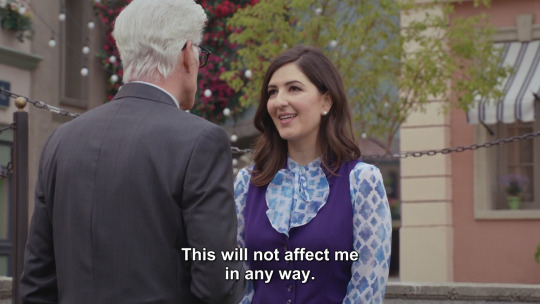
8K notes
·
View notes
Text
If you like Science, use ao3 (writer, reader, both, some nebulous other usage I have yet to figure out) and enjoy sharing your opinions on fanfic and fandom, I'd be hugely grateful to anyone willing to take part in a short survey!
It's anonymous (you can use whatever name you like) and the answers will be used for my paper on fan archives, fandom, and how fans relate to the two. The survey will stay open for a week starting today.
If you want to take part, click here!
269 notes
·
View notes









